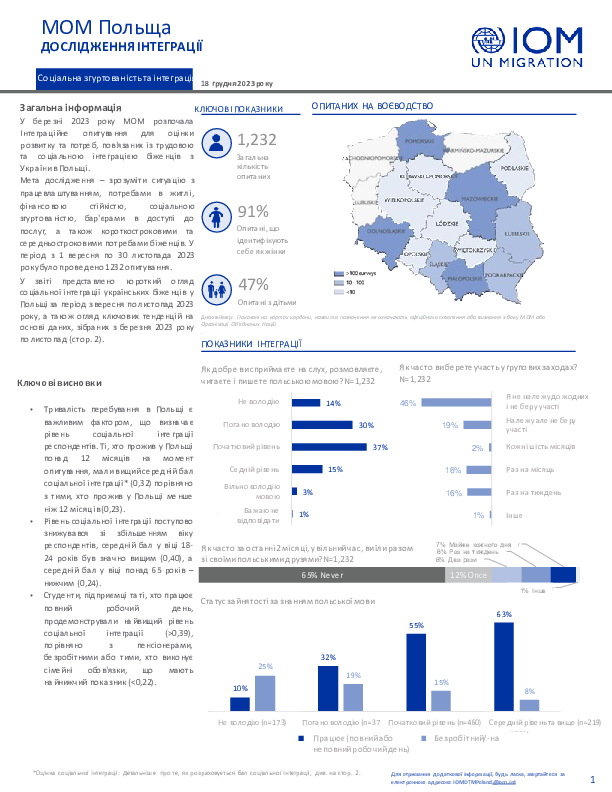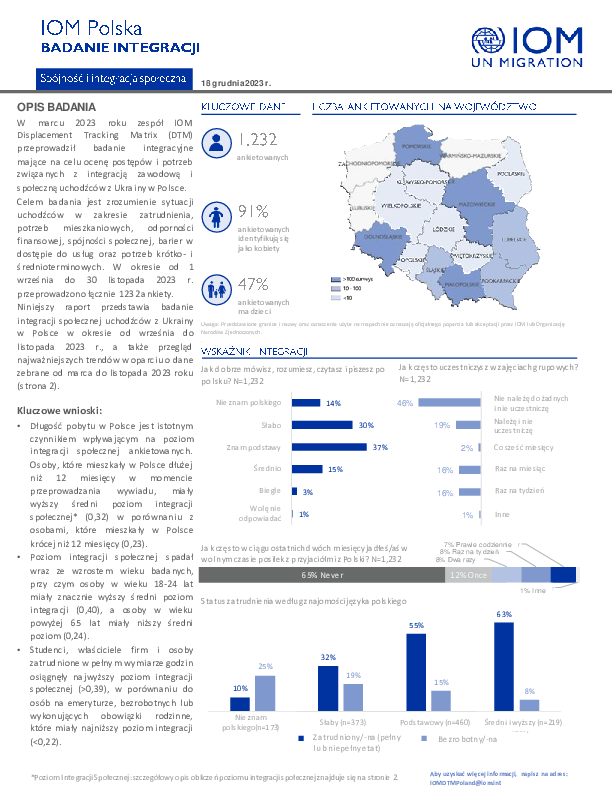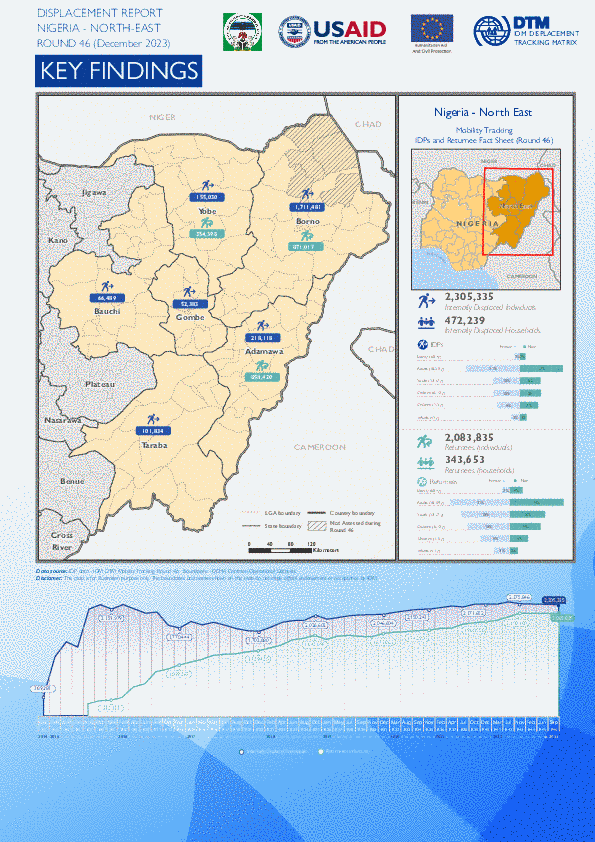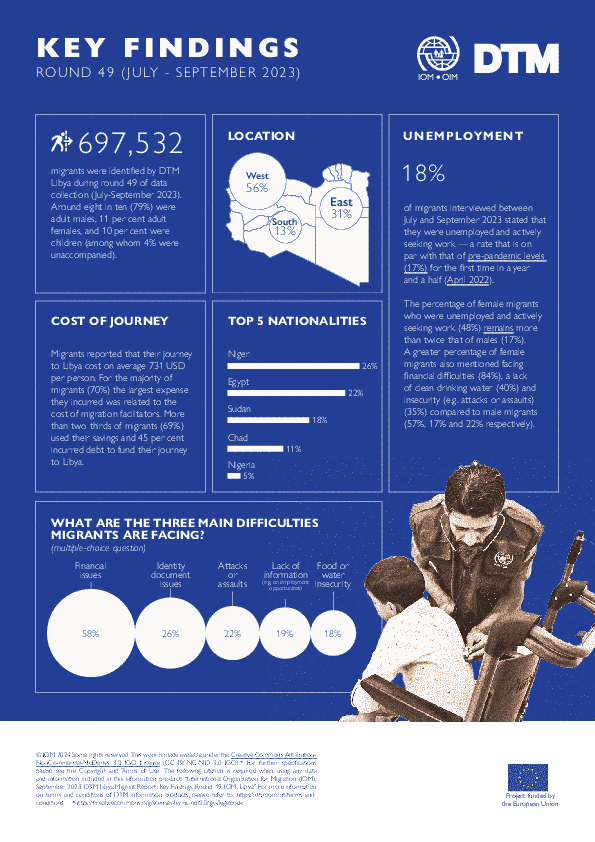-
Countries
-
Data and Analysis
-
Special Focus
-
Crisis Responses
Contact
DTM Sudan, DTMSudan@iom.int
Location
Sudan
Activity
- Mobility Tracking
- Baseline Assessment
Period Covered
Apr 15 2023 -Dec 27 2023
From 15 April 2023, armed clashes erupted between the Sudanese Armed Forces (SAF) and the Rapid Support Forces (RSF). As a result of the military clashes, DTM Sudan estimates that 5,942,580 individuals (1,182,895 households) were recently internally displaced. The internally displaced persons (IDP) caseload was observed in 6,213 locations across all of Sudan’s 18 states.*
The highest proportions of IDPs were observed across South Darfur (13%), East Darfur (11%), River Nile (11%), Aj Jazirah (8%), and North Darfur (8%).
*The data from many locations has been gathered with the co-ordination of the Humanitarian Aid Commission.
A more detailed version of this dataset is available, to get access kindly click on the 'Request Access' button
Population Groups
IDPs
Survey Methodology
Unit of Analysis Or Observation
Admin Area 3
Site or Location
Type of Survey or Assessment
Key Informant
Keywords
Geographical Scope Partial Coverage
Administrative boundaries with available data
The current dataset covers the following administrative boundaries
Contact
DTM Sudan, DTMSudan@iom.int
Location
Sudan
Activity
- Mobility Tracking
- Baseline Assessment
Period Covered
Apr 15 2023 -Dec 13 2023
From 15 April 2023, armed clashes erupted between the Sudanese Armed Forces (SAF) and the Rapid Support Forces (RSF). As a result of the military clashes, DTM Sudan estimates that 5,540,232 individuals (1,102,100 households) were recently internally displaced. The internally displaced persons (IDP) caseload was observed in 6,089 locations across all of Sudan’s 18 states.
* The highest proportions of IDPs were observed across South Darfur (13%), East Darfur (12%), River Nile (11%), Aj Jazirah (9%), and North Darfur (8%).
Field teams reported that the IDPs were originally displaced from eleven states. The majority (3,541,219, 64%) were reportedly displaced from Khartoum state; followed by South Darfur (17%), North Darfur (9%), Central Darfur (4%), West Darfur (3%), East Darfur (1%), South Kordofan (1%), North Kordofan (1%), West Kordofan (<1%), White Nile (<1%), and Aj Jazirah (<1%) .
*The data from many locations has been gathered with the co-ordination of the Humanitarian Aid Commission.
A more detailed version of this dataset is available, to get access kindly click on the 'Request Access' button
Population Groups
IDPs
Survey Methodology
Unit of Analysis Or Observation
Admin Area 3
Site or Location
Type of Survey or Assessment
Key Informant
Keywords
Geographical Scope Partial Coverage
Administrative boundaries with available data
The current dataset covers the following administrative boundaries

Contact
iompanama@iom.int
Language
Spanish
Location
Panama
Period Covered
Dec 01 2023
Dec 28 2023
Activity
- Survey
La región de América Central y México se ha caracterizado por ser uno de los corredores migratorios más importantes del mundo. A lo interno se pueden identificar varios flujos migratorios. Por ejemplo, el tránsito de personas migrantes altamente vulnerables provenientes de Centro y Sur América, el Caribe, Asia y África con rumbo hacia el norte del continente. Así como la migración circular por movilidad laboral, entre fronteras de dos o más países.
Este último tipo de migración puede entenderse como un patrón de movilidad humana internacional continuo, a largo plazo y fluido, entre países que crecientemente son reconocidos como parte de un mismo espacio económico.
Este tipo de movilidad existe en la frontera entre Panamá y Costa Rica desde hace décadas, la población indígena Ngäbe - Buglé se moviliza desde sus tierras actuales a las zonas altas de la provincia de Chiriquí y la Zona Sur de Costa Rica para trabajar principalmente como recolectores en el cultivo de café durante las zafras o períodos de alta cosecha.
Cada año, desde julio hasta por seis meses se inicia la movilización de personas migrantes para trabajar en la cosecha de café. En promedio, el Servicio Nacional de Migración (SNM) de Panamá, emite nueve mil salvoconductos a población indígena Ngäbe - Buglé al año, para su cruce fronterizo y trabajo en Costa Rica. Estos documentos de viaje forman parte de la colaboración interinstitucional del SNM y el Ministerio de Trabajo y Desarrollo Laboral de Panamá, gobiernos locales, y contrapartes costarricenses que coordinan la migración laboral regular de trabajadores y trabajadoras Ngäbe - Buglé, para la provisión de servicios y protecciones en sus lugares de empleo temporal.

Contact
dtmlebanon@iom.int
Language
English
Location
Lebanon
Period Covered
Oct 10 2023
Jan 09 2024
Activity
- Mobility Tracking
- Baseline Assessment
Since October 8 there has been an increase in cross-border incidents between Israel and Lebanon, resulting in the displacement of people both within the South and elsewhere within the country. Since October 10, the Displacement Tracking Matrix (DTM) has been conducting the daily monitoring of population movements. The objective of the exercise is to inform preparedness and response planning.

Contact
DTM Poland IOMDTMPoland@iom.int
Language
English
Location
Poland
Period Covered
Sep 01 2023
Nov 30 2023
Activity
- Survey
У березні 2023 року МОМ розпочала Інтеграційне опитування для оцінки розвитку та потреб, пов'язаних із трудовою та соціальною інтеграцією біженців з України в Польщі.
Мета дослідження – зрозуміти ситуацію з працевлаштуванням, потребами в житлі, фінансовою стійкістю, соціальною згуртованістю, бар'єрами в доступі до послуг, а також короткостроковими та середньостроковими потребами біженців. У період з 1 вересня по 30 листопада 2023 року було проведено 1232 опитування.
У звіті представлено короткий огляд соціальної інтеграції українських біженців у Польщі за період з вересня по листопад 2023 року, а також огляд ключових тенденцій на основі даних, зібраних з березня 2023 року по листопад.
- Тривалість перебування в Польщі є важливим фактором, що визначає рівень соціальної інтеграції респондентів. Ті, хто прожив у Польщі понад 12 місяців на момент опитування, мали вищий середній бал соціальної інтеграції* (0,32) порівняно з тими, хто прожив у Польщі менше ніж 12 місяців (0,23).
- Рівень соціальної інтеграції поступово знижувався зі збільшенням віку респондентів, середній бал у віці 18-24 років був значно вищим (0,40), а середній бал у віці понад 65 років – нижчим (0,24).
- Студенти, підприємці та ті, хто працює повний робочий день, продемонстрували найвищий рівень соціальної інтеграції (>0,39), порівняно з пенсіонерами, безробітними або тими, хто виконує сімейні обов'язки, що мають найнижчий показник (<0,22).

Contact
DTM Poland IOMDTMPoland@iom.int
Language
English
Location
Poland
Period Covered
Sep 01 2023
Nov 30 2023
Activity
- Survey
W marcu 2023 roku zespół IOM Displacement Tracking Matrix (DTM) przeprowadził badanie integracyjne mające na celu ocenę postępów i potrzeb związanych z integracją zawodową i społeczną uchodźców z Ukrainy w Polsce.
Celem badania jest zrozumienie sytuacji uchodźców w zakresie zatrudnienia, potrzeb mieszkaniowych, odporności finansowej, spójności społecznej, barier w dostępie do usług oraz potrzeb krótko- i średnioterminowych. W okresie od 1 września do 30 listopada 2023 r. przeprowadzono łącznie 1232 ankiety.
Niniejszy raport przedstawia badanie integracji społecznej uchodźców z Ukrainy w Polsce w okresie od września do listopada 2023 r., a także przegląd najważniejszych trendów w oparciu o dane zebrane od marca do listopada 2023 roku.
- Długość pobytu w Polsce jest istotnym czynnikiem wpływającym na poziom integracji społecznej ankietowanych. Osoby, które mieszkały w Polsce dłużej niż 12 miesięcy w momencie przeprowadzania wywiadu, miały wyższy średni poziom integracji społecznej* (0,32) w porównaniu z osobami, które mieszkały w Polsce krócej niż 12 miesięcy (0,23).
- Poziom integracji społecznej spadał wraz ze wzrostem wieku badanych, przy czym osoby w wieku 18-24 lat miały znacznie wyższy średni poziom integracji (0,40), a osoby w wieku powyżej 65 lat miały niższy średni poziom (0,24).
- Studenci, właściciele firm i osoby zatrudnione w pełnym wymiarze godzin osiągnęły najwyższy poziom integracji społecznej (>0,39), w porównaniu do osób na emeryturze, bezrobotnych lub wykonujących obowiązki rodzinne, które miały najniższy poziom integracji (<0,22).
Contact
dtmlibya@iom.int
Location
Libya
Activity
- Mobility Tracking
- Baseline Assessment
Period Covered
-Jul 01 2023
Population Groups
Migrants Present
Survey Methodology
Unit of Analysis Or Observation
Admin Area 3
Admin Area 4
Type of Survey or Assessment
Keywords
Geographical Scope
Administrative boundaries with available data
The current dataset covers the following administrative boundaries

Contact
DTM Libya, DTMLibya@iom.int
Language
English
Location
Libya
Period Covered
Jul 01 2023
Sep 30 2023
Activity
- Mobility Tracking
- Baseline Assessment
IOM Libya’s Displacement Tracking Matrix (DTM) programme identified a total of 697,532 migrants from over 45 nationalities in the 100 Libyan municipalities during round 49 of data collection (July - September 2023). The number of migrants in Libya has continued to decrease slightly compared to the previous round of data collection (from 704,369 migrants, round 48 to 697,532 migrants, round 49) in line with a trend that started at the beginning of 2023 when there were 706,472 migrants (round 46, January - February 2023).

Contact
DTM Nigeria, iomnigeriadtm@iom.int
Language
English
Location
Nigeria
Period Covered
Jul 17 2023
Sep 30 2023
Activity
- Mobility Tracking
- Baseline Assessment
Data collection for IDPs took place between July and September 2023 in 2,068 localities in the six states of north-east Nigeria (Borno, Adamawa, Yobe, Gombe, Taraba and Bauchi). Data collection for returnees took place during the same assessment period in the BAY states of north-east Nigeria (Borno, Adamawa and Yobe).
The DTM identified a total of 2,305,335 IDPs in 472,239 households and 2,083,835 returnees in 343,653 households. The IDP population included IDPs in camps and camp-like settings (929,453 individuals or 40%) and IDPs residing in host communities (1,375,882 individuals or 60%). The returnee population included IDP returnees (1,874,283 individuals or 90%) and returnees from abroad (209,552 individuals or 10%).

Contact
DTM Libya, DTMLibya@iom.int
Language
English
Location
Libya
Snapshot Date
Sep 30 2023
Activity
- Flow Monitoring
- Mobility Tracking
- Baseline Assessment
This infographic presents the key findings of Round 49 of the mobility tracking and flow monitoring components of the Displacement Tracking Matrix (DTM) programme in Libya.